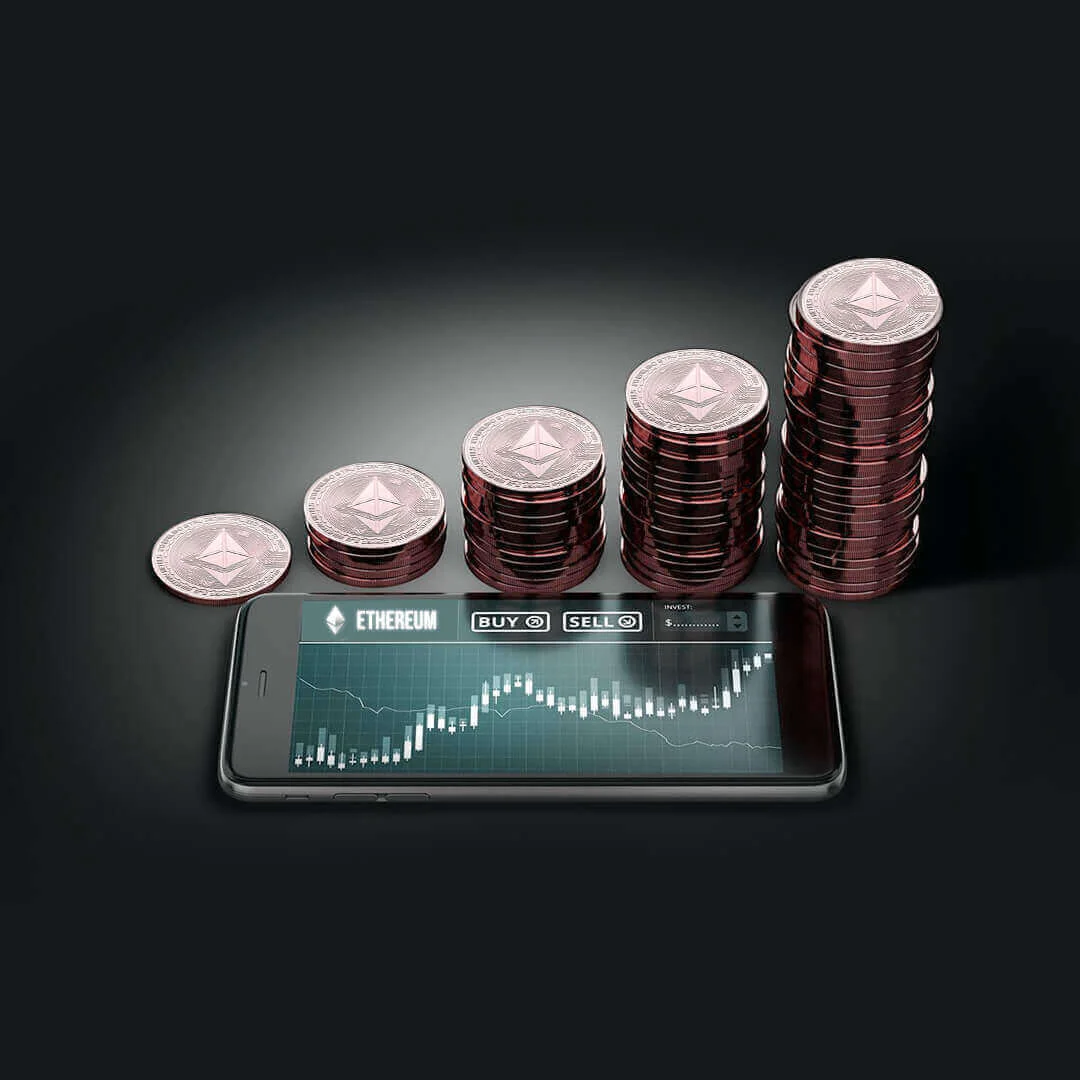Ethereum Leverage Trading
Seize capital investment opportunities with our expertise!








Ethereum Leverage Trading
Ethereum leverage trading is becoming very popular amongst traders. However, it has only been a few years since leverage trading ethereum was initiated.
Created in 2015 by Vitalik Buterin, the primary purpose of Ethereum was to support and facilitate the easy payment function of Bitcoin. The Ethereum platform also allows developers to program decentralized applications powered through smart contracts. Thus the developers can create dapps like lending and borrowing on the Ethereum network. Besides this the Ethereum platform also facilitates token for arts and digital products like NFTs, securing public records, and much more. Over 80 billion USD in various smart contracts are staked by individual and corporate investors in the DeFi industry, which Ethereum powers.
Ether, the native currency of Ethereum, is used for paying transaction fees on the network. Each transaction you perform on the network requires that you pay a fee in Ether for the transaction to be validated by validators on the network, even if you are a dapp developer creating smart contracts. Such transaction fees are technically called gas fees. The gas fees differ depending on how busy the network is and how complicated the smart contract transaction is.
Ethereum Margin Trading
Margin trading is a trading strategy that requires less capital to invest while reaping huge profits compared to other cryptocurrency trading strategies. Thus this is becoming very popular amongst traders.
While trading Ethereum with margin, the traders will invest a portion of the price of Ethereum, and the rest of the price is borrowed from the cryptocurrency broker or firm.
For example, the price of Ethereum is trending at $1,000, and the margin money required for entering the market is also $1000, but the trader has limited funds and wishes to trade Ethereum.
Here comes the cryptocurrency broker or the firm. First, the broking firm or the broker allows the trader to trade by entering through margin trading. For example, suppose the broker asks for 45% of the minimum margin money to enter the trade while the broker loans the remaining money to that trader.
So when Ethereum is trending at $1,000, the trader enters into margin trading with 45%, i.e., $450, while the broker loans the trader $550.
The trader is now exposed to the risk of the underlying asset and can trade easily. The chances of profit and loss are dependent on the research done by the trader to anticipate the price movement of Ethereum.
This strategy is generally used when the price trend of Ethereum is bullish for a short period, and the trader who wishes to enter the market and exploit the situation has little money to invest.
Benefits of Trading Ethereum
Ethereum is the second most ranked cryptocurrency after Bitcoin in market capitalization. The average daily trading volume of Ethereum is roughly $35 billion, thus making it pretty liquid while trading. In addition, most DeFi applications are built on the Ethereum platform and continue to do so. Thus the popularity of Ethereum continues to grow.
Since Ethereum is a cryptocurrency, the crypto market is known to be open throughout the year 24X7, including public holidays. As a result, traders can learn a lot about the current trends in token movements and Ethereum itself through Ethereum block explorers. Additionally, it is possible to forecast and estimate changes in the price of Ethereum that a shortage of network resources might bring on by a high demand for complicated applications.
Trading Ethereum with leverage
Another popular trading strategy is Ethereum leverage trading. Instead of owning the underlying asset, the traders can trade on the underlying asset’s price.
Leverage is a tool that can magnify the profit when used correctly or can also magnify loss if the trader does not interpret the market sentiments.
You can open both long and short positions while using leverage. For example, you would wish to opt for a long position if you expect the price of Ethereum will go up. Similarly, you will go short if the price of Ethereum is falling. While this could appear to be typical spot trading, using leverage enables you to purchase or sell assets based solely on your collateral and not your holdings. Thus regardless of whether you own the underlying asset or not, you have the option of borrowing and selling it if, as per your research, the market falls.
What is leverage in crypto trading?
Using borrowed capital to make trades is called leverage in cryptocurrency trading. Leverage allows you to trade in larger volumes by magnifying your buying and selling power; thus, with small capital, you have the opportunity to make more money. However, leverages are double-edged swords, as they provide you the opportunity to amplify your profits. On the other hand, you are at the risk of substantial loss if you misinterpret the market sentiments.
How does leveraged trading work?
Before you start ethereum leverage trading with leverages and borrow funds, you must have funds in your trading account. The initial capital provided by you is called collateral. The initial capital varies depending upon the leverage and the total value of the position you wish to open, known as margin.
For example, if you wish to invest $1,000 in Ethereum (ETH) and leverage 10X, the margin required would be 1/10 of $1,000. In other words, you need to keep $100 as collateral for the borrowed funds. On the other hand, if you opt for 20X leverage, the margin would be lower than 1/20 of $1,000 is $50. However, the chance of being liquidated increases with leverage.
It would help if you also had a margin threshold for your trades and the initial margin deposit. As the market swings against your position, the margin falls below the maintenance threshold; as a result, you must add more money to your account to keep it from being liquidated. The threshold may also be referred to as the maintenance margin.
While applying leverage, positions can be opened on both the long and short sides. If you think the price of ethereum will increase, you should choose a long position. The same applies if Ethereum’s price declines—you would go short. While it can seem like standard spot trading, applying leverage allows you to buy or sell assets based only on your collateral rather than your holdings. Because of this, whether you own the underlying asset or not, you have the choice to borrow it and sell it if, as predicted by your study, the market declines.
Example of a leveraged long position
Suppose you wish to open up a long position of $1,000 worth of Ethereum with 10X leverage; in other words, you will require $100 as collateral. If the price of Ethereum goes up by 20%, you will earn $200 as a net profit after deducting fees, which is higher than earning $20 if you traded only $1,000 capital without using leverage.
However, had the price dropped by 20%, you would make $200 as a loss. But since you have kept $100 as collateral, the drop would cause a liquidation, or in other words, your balance would go zero. So even if the drop had been 10% down, you still would have lost your $100. Thus depending upon the exchange, you are using the exact liquidation value would depend.
Thus it is advisable to add more funds to your account, increasing collateral. Generally, a margin call would be sent by the exchange before liquidation happens.
Example of a leveraged short position
Now consider that you wish to open a $1,000 short position with 10X leverage; again, you would be borrowing Ethereum from someone else and selling them at the current market price. Your collateral is $100, and as you are trading on 10X leverage, then you are in a position to sell $1,000.
However, the current price of Ethereum is $4,000, and you have borrowed 0.25 ETH and sold it. If the price of Ethereum drops to 20%, that is $3,200; then you can buy back 0.25 ETH with just $800 giving you a net profit after deducting the fees of roughly $200.
But if Ethereum rises 20% to $4,800, you will need an extra $200 to buy back the 0.25 ETH. since you hold only $100 as collateral, it will get liquidated. Thus it is essential to maintain reasonable funds in your account.
About us


Why Choose Us ?
Frequently Asked Questions
How to manage risks with leveraged trading?
It would help if you remembered that leverage offers enormous potential to increase the chances of making a significant profit with less capital. However, using leverages has its own pitfalls too:
You are exposing yourself to unnecessary risks; if you fail to do enough research before using leverages, you are at equal risk of making a considerable loss.
You will have a smaller volatility tolerance if the leverage is high.
You have more margin of error to trade if you use lower leverage.
You can employ risk management strategies like stop-loss and take-profit orders that ensure that you mitigate leveraged trading. Stop-loss is a tool that guarantees that you don’t make a huge loss if the price trend of Ethereum is going against the one which you have speculated. The assets are sold once the stop-loss level is reached. Take order is another feature that works directly opposite the stop-loss feature. Once a certain profit level is reached, the assets are sold, and you make a profit. Thus you enjoy the risk of Ethereum while mitigating losses and increasing your profit.
What Is Leverage?
Leverage is a strategy in finance that uses borrowed money to increase the profit potential. In other words, the trader or the investor borrows funds to inflate the exposure of a certain asset, project, or instrument. For example, the trader or the investor might lack the necessary funds to enter the cryptocurrency market. Thus these traders or investors borrow funds from the broker or the exchange. Thus with the help of leverage, the traders multiply their power of buying in the market.
A common example in our daily lives is when you go and buy a TV with a credit card or use mortgages to buy a home.
Leverage is common in everyday life, too. Leverage is used, for instance, when using a credit card to purchase a television or a mortgage to finance a home purchase.
Leverages in Margin Trading
Margin trading, simply put, is trading asets with funds collected by other parties. It is quite similar to direct borrowing, it gives you greater sums of capital and allows you to leverage your position. One significant difference is that while the margin position is open, your assets act as collateral for the borrowed funds.
Best Exchanges To Trade Crypto With Leverage
Blockchain Tradein is one of the best cryptocurrency exchanges you need to consider trading with. Numerous users enjoy the maximum liquidity, trading volume, and other perks offered by the platform.
BTI supports margin trading, which you can understand and execute in just a few simple steps.
How to leverage trade on Blockchain Tradein?
To get started with Blockchain margin trading, you will first have to complete your identity verification (KYC). You can use margin trading for both short and long position.

